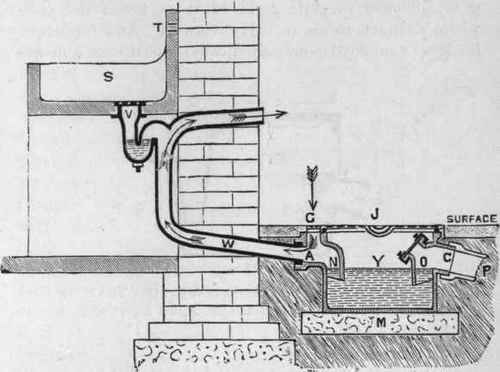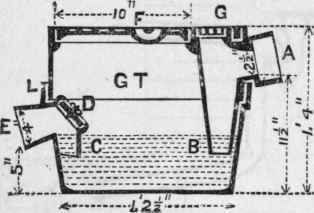Chapter XXXIV. Scullery Sinks
Description
This section is from the book "Principles And Practice Of Plumbing", by S. Stevens Hellyer. Also available from Amazon: Principles and practice of plumbing.
Chapter XXXIV. Scullery Sinks
THE general sink in the scullery, into which all kinds of liquids and matter are emptied, from green-water to greasy matters, should be made of a non-absorbent material, such as stoneware or fire-clay. Or if the sink is to answer the double purpose of receiver and washer, i.e., if instead of washing the dinner-plates, etc., in a tub placed within the sink, the sink itself is to be used for the purpose, then instead of fixing a sink of non-elastic material, as stoneware or fire-clay, a wood sink lined with tinned copper should be fixed, copper being sufficiently elastic to prevent the breakage of crockery ware, and its surface being smoother and therefore cleaner than lead. In such cases the depth of the sink should not be less than about 11 or 12 in., with its front well sloped back towards the bottom; and where the sink would be much used, and the usage would be rough, the copper sides should not be less than 2 1/4 lbs. to the superficial foot, and the bottom about 3 1/4 lbs., but a greater strength still would be preferable. The top edges should be protected from the wear and tear of utensils over them by oak cappings secured to the sink by brass cups and screws.
2. There should be no openings, spaces, or crevices round about the tops of the sinks where filth could fall into and become a nuisance. The draining-board should sail over the edge of the sink, with a water-groove on its underside, to prevent the drainings running back over the top edges of the sink and dropping on to the floor, or to keep them from soaking into the woodwork.
3. Where the wash-up sinks are lined with tinned copper, the draining-board should also be covered with tinned copper, with draining-channels properly formed in same. Or the draining-board could be covered with lead, as the latter could easily be dressed into the grooves or channels, for carrying off the drainings from the plate-rack. Or milled lead, with a corrugated upper surface, could be fixed on the draining-board.
4. For washing vegetables - where it could be well afforded - a separate sink with two compartments should be fixed, made either of slate or fire-clay, one compartment being used for washing the vegetables in and one for rinsing. The sink should be about 1 ft. deep, and the front should slope well back towards the bottom, to give room for the knees and clothes.
Next the division, in the back corner of the bottom of the compartment for holding water, should be fixed a 2 1/2 in. (or 3 in. or 2 in.) brass washer, with a cobweb-grating, fly-nut and union, fitted with a ground-in brass hollow plug, to which should be soldered or brazed a tinned copper trumpet-pipe to form the overflow. And this standard overflow should be protected by a tinned copper movable perforated guard, to prevent damage from potatoes, turnips, and such like vegetables. A similar arrangement could also be fixed in the rinsing compartment; but where this compartment is not required to hold water, a simple brass cobweb - grating of good strength, or a rim and grate, soldered to the trap, is all that is necessary.
A lead trap can be fixed under such compartment, and the waste-pipes branched into one pipe and carried through the wall; but as the discharges from such sinks would not be of a foul character, there is no reason why one trap should not take the wastes from the two sinks; and then where the waste-pipe, to reach the disconnecting-trap outside, would not be of a long length, and would not have more than 2 or 3 ft. fall, there would be no necessity to vent it to prevent syphonage. 5. There is no difficulty in disposing of the waste-pipe from the vegetable washers; that, in all cases, should discharge with an open end, into a self-cleansing stoneware drain-interceptor fixed outside the house.

Fig. 147. - Section of a Stoneware "Drain-Interceptor."
6. But there is often great difficulty in determining the best method of treating the waste-pipe from the general sink; for it is impossible to pass bodies of greasy water through a drain, and for the drain at all times to keep as wholesome as would have been the case had the grease been intercepted by a grease-intercepting trap, as shown in fig. 148 or fig. 149. But where the grease is caught in such a fashion it must be carried away. There is no difficulty about this in country houses, or in houses with gardens to them, for then the gardener, or some odd man or boy about the place, can clean out the trap once a week and bury the grease; but a better use should be found for it. In some cases that I know of, it is boiled down, clarified, and used for greasing cart wheels, etc. [I have only recently examined the drains of several houses that have been treated in this way for several years, and one for ten years, and I found the drain in each case beautifully clean and free from grease. And in no case was there a flushing-tank for flushing out the drain.]

Fig. 148. - Section of "Grease-Intercepting Trap" in Stoneware.
7. But though there is no difficulty in getting rid of the grease and filth from grease-traps in the country, there is great difficulty in getting rid of it in towns and cities where dustmen refuse to carry it away. And for householders to employ labour periodically - about once a month

Fig. 149. - Section of "Grease-Intercepting Trap" in Cast Iron, in two pieces, for Inlet, A, to be turned round to suit Drain.
- to clean out the grease-trap, and then to have to pay for the removal of the grease and filth, means a yearly expense of a few pounds that can ill be afforded in these hard times and heavy expenses. And this is not all, for in the case of most terrace houses the grease would have to be carried right through the house, and where such matters are not deodorized this would become a nuisance.
8. It has often been a wonder to me that the authorities should allow grease to enter a sewer, but as there is no objection to this, the best way of getting rid of grease in towns and cities is to intercept it by the use of some such trap as shown in fig. 150, and to flush it through the drain to the sewer, in congealed pieces, once or twice a day, according to circumstances.
The stoneware flushing-rim "Flush-out" grease trap, fig. 150, has been designed and patented by me. It is provided with single or double inlet arms on one or both sides of the trap, for receiving the waste-pipe or waste-pipes, from one or more sinks, as may be required.

Fig. 150. - "Flush-out" Grease-Trap.
9. Where the general sink in the scullery is also used for washing dinner-plates and greasy things in, and it ismade to hold a large body of water, a grease-trap is generally found to be quite unnecessary. Several houses have been treated in this way by my firm during the last six or seven years with great success. In some small houses, however, where the usual grease-trap was dispensed with, and the sinks were small and shallow, and where a good table was generally kept, the sewer disconnecting-trap became clogged at times with grease, and all sorts of evil things followed; but a twenty-gallon flushing-tank for washing the grease through the drain once or twice a day remedied the evil.
Continue to:


